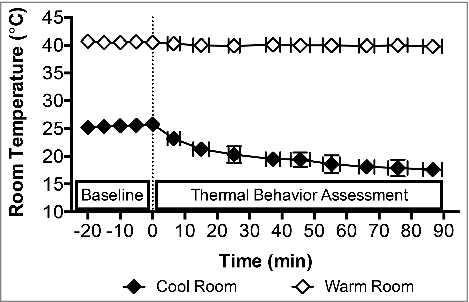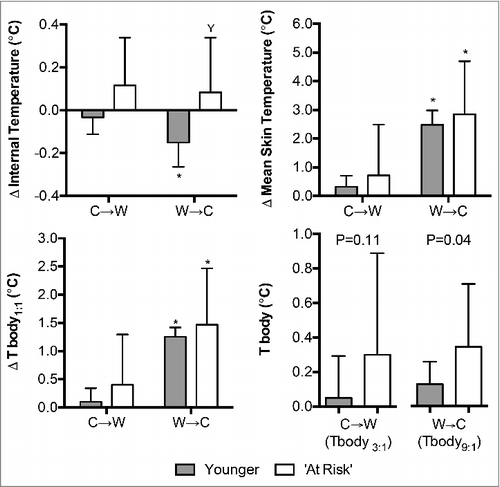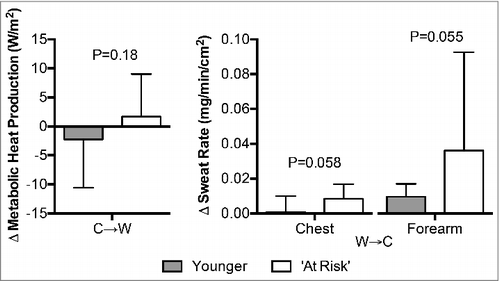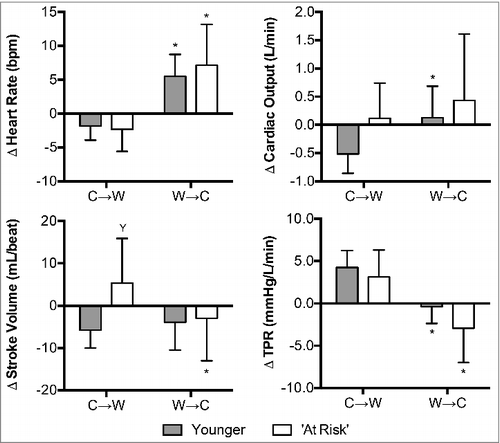Figures & data
Table 1. Subject characteristics.
Figure 1. Temperature dynamics of the cool and warm rooms. Baseline measurements were taken at 0 min in the cool room after 20 min seated rest in a 25.5 ± 0.7°C (24 ± 6% relative humidity) environment. After the Baseline period, the cool room was set to 17.6 ± 1.2°C (36 ± 12% relative humidity) and the 90 min behavioral assessment commenced (dashed line) in the midst of this progressive room cooling. The warm room was maintained at 40.0 ± 0.6°C (20 ± 0% relative humidity) throughout, while the average temperature in the cool room during the thermal behavioral assessment was 18.1 ± 1.8°C (29 ± 5% relative humidity). Mean ± SD, n = 18 (Younger: n = 12, ‘At Risk’: n = 6).

Table 2. Baseline values.
Table 3. Thermal behavior characteristics and perceptual responses.
Figure 2. Changes (Δ) in intestinal, mean skin, and mean body temperatures upon the decision to move from cool-to-warm (C→W) and from warm-to-cool (W→C) in younger adults (n = 12) and ‘at risk’ older adults (n = 6). Mean ± SD, * different from C→W (P ≤ 0.02), Y different from younger (P = 0.02). Tbody1:1: mean body temperature with internal and mean skin temperatures weighted 1:1, Tbody3:1: mean body temperature with internal and mean skin temperatures weighted 3:1, Tbody9:1: mean body temperature with internal and mean skin temperatures weighted 9:1.

Figure 3. Changes (Δ) in forearm and fingertip skin blood flow (SkBF) and cutaneous vascular conductance (CVC) upon the decision to move from cool-to-warm (C→W) and from warm-to-cool (W→C) in younger adults (n = 12) and ‘at risk’ older adults (n = 6). Mean ± SD, * different from C→W (P < 0.01), Y different from younger (P ≤ 0.04).

Figure 4. Changes (Δ) in metabolic heat production upon the decision to move from cool-to-warm (C→W), and chest and forearm sweat rate upon the decision to move from warm-to-cool (W→C) in younger adults (n = 12) and ‘at risk’ older adults (n = 6). Mean ± SD, actual p-values are reported.

Figure 5. Changes (Δ) in mean arterial pressure, systolic pressure and diastolic pressure upon the decision to move from cool-to-warm (C→W) and from warm-to-cool (W→C) in younger adults (n = 12) and ‘at risk’ older adults (n = 6). Mean ± SD, * different from C→W (P < 0.01), Y different from younger (P ≤ 0.05).

Figure 6. Changes (Δ) in heart rate, stroke volume, cardiac output, and total peripheral resistance (TPR) upon the decision to move from cool-to-warm (C→W) and from warm-to-cool (W→C) in younger adults (n = 12) and ‘at risk’ older adults (n = 6). Mean ± SD, * different from C→W (P ≤ 0.05), Y different from younger (P ≤ 0.02).

Figure 7. Changes (Δ) in rate pressure product (RPP), cardiac power output, and stroke work upon the decision to move from cool-to-warm (C→W) and from warm-to-cool (W→C) in younger adults (n = 12) and ‘at risk’ older adults (n = 6). Mean ± SD, * different from C→W (P < 0.01), Y different from younger (P < 0.01).

